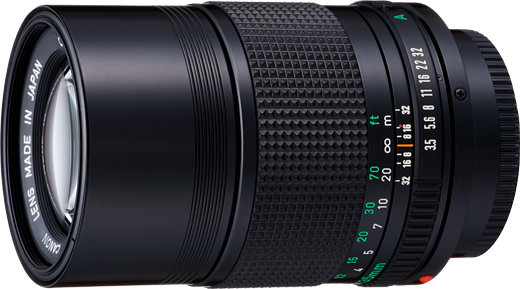
| Year | 1979 |
| Lens Groups | 4 |
| Lens Element | 4 |
| Aperature Blades | 6 |
| Minimum Aperture | f/32 |
| Closest Focusing | 1.3 m |
| Max. Magnifcation | 1:7.7 (0.13x) |
| Filter Size | 52 mm |
| Diameter x Length | 63 x 85 |
| Weight | 325 gr (0.72 lb) |
| Hood | - |
| Beefiness | 1.23 |
This is an underrated lens. It's sharp, has very little vignetting fully open, it's lightweigt and it's got that practical built-in hood and almost no CA.
The most common 52 mm filter thread makes it usable with most of my filters.
However it's great IQ, i do not use it that much because the focal length feels like a compromise between a portrait lens and a tele. In situations where i need some telephoto i usually mount the 70-210 f4 zoom, but i guess the 135 prime produces a slightly better image.
loved this lens on my A-bodies for portrait and now love it for nature pictures on my Nikon D70.
Couldn´t find anything wrong at this lens.
It seems like it's hard to go far wrong on a 135mm lens. This one is about average IQ among the eight or so that I have, but it is easily the lightest and slightly smaller than average (although most of the others are f/2.8). Bokeh are ok, without a bright ring but with an abrupt edge to the disc that leaves obvious sharp line artifacts. However, contrast seems to drop considerably in out-of-focus regions, perhaps due to internal reflections?
The wide angle FDn lenses all seem to focus fairly close, so I was surprised to see this doesn't.
The build is FDn plastic, but quite functional. The 7.5 reflects a bonus of 0.5 for the built-in shade, which is really well done and rather like the one built-into the earlier Vivitar 135mm f/2.8. The bad news is I think that Vivitar is a better lens in nearly every way -- and it's cheaper.
In summary, this is yet another perfectly usable, yet unspectacular, FDn lens.
very nice lens. I used it in the 80ies. Since FD-Lenses are cheap today I would recommend the newFD 135/2.8 (which I use now) or the FD135/2.5 S.S.C.
This is a really excellent lens for many practical reasons, especially when used at middle apertures. Yes, there is a wider-aperture version, but it is huge and heavy. The f/3.5 version can yield very pleasing high-contrast images with excellent resolution if used from about f/4 and up - though the smallest apertures should, as with most lenses, be used as an exception rather than a rule. It is a surprisingly lightweight lens but is of a beautifully-crafted all-metal high-quality construction. It's also quite small.
I really like this lens and find that it doesn't add any real extra weight to my camera bag but brings with it a very handy focal length. 135mm is excellent for a wide range of applications - I think it's a bit of a neglected focal length to be honest. With this being an f/3.5 lens it is not so well suited for low-light photography; however under average daylight conditions it is excellent for travel, portraiture, landscape, and - especially - for architecture for which its high contrast and very pleasing flatness of perspective are very useful for capturing a sense of space, surface texture of building materials, and interesting shapes. This assertion may seem like it comes from pretty far left-field, and it's just a personal observation, but if I were going out specifically to shoot buildings, this is the lens I would have with me. The built-in lens hood is also very useful when you're constantly pointing your camera upwards at rooftops, and I find that it works very well with the lens.
These are very easy to come by on eBay for extremely reasonable prices. If you have an AE-1, one of these 135's, a 50mm f/1.8, and a 28mm f/2.8 you have a really nicely-rounded three-lens kit that will cover you for almost all your photographic needs, that won't break the bank, or your back, and will fit into a quite small camera bag!